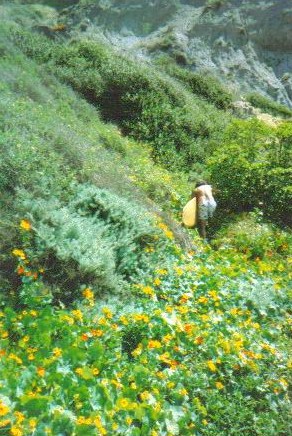Richard Safady Paipo
Interview
March 4, 2010, Torrance, California
Questions and e-mail interview by Bob Green
1. When and where did you start surfing?
I began riding waves in Hermosa Beach, Southern California, in 1970. Sand bottom.
2.
Paul Gross has stated that after riding stand-up for many years you
started riding on your knees in the 1980s, and riding prone in the
1990s. What is the story behind this path?
Knees
- because I was not a good upright rider. Losing the board often.
Refused to wear a cord. Prone - close to the curl. View, great! My hand is on the rail for stability. Higher percentage of waves
makeable proneing, at a southern Baja low tide location.
|

Photo by: Thomas Kampas.
|
3. Were you exposed to any bellyboarders or paipo riders during your transition from stand-up surfing?
Paipo,
no. Kneeboarders, yes. Fotos and movie footage of George Greenough.
Locals in Palos Verdes, California. The Australian kneelo film 'Chasing
the Sparrow.' Will James (Redondo Beach, CA.) as a proner.
4. How did friends respond to your changed styles of wave riding? Did others treat you differently in the line-up?
Curious
looks. Treated me no different in the lineup. If they barked, it was
"stand up." I only do, if they reward me with ice cream.
5. Who has made your prone boards? Have you stuck to a basic design or has there been a lot of evolution?
Scott Anderson (Marina Del Rey), Phil Becker (Hermosa Beach), Paul Gross, Spencer Kellogg (Ventura), Greg Liddle (Kapaa, Kauai). Basic design, the same. Evolution was with fins.
Photo by: Richard Safady.
|

|
6. Tell me about your prone boards: the dimensions, design features?
Must
have width (around 23 inches), 50/50 center rails, a displacement hull
bottom, no tail rocker, very slight nose rocker, a weight of around 13
pounds and a lenth of about 9 feet. I use a single 9.5 inch
Liddle/Greenough flex tip fin (strength at the base). The board is flat
under the tail, has a slight dome on the center deck, a single
stringer, and the nose and tail have turned down rails (sharper at the
tail). No color, no leash, no Logos. 6-ounce cloth top and bottom. Fin
box patch for strength.
These boards were made by by Scott Anderson of Marina Del Rey, Calif.,
and Greg Liddle of Kapaa, Kauai, Hawaii. The board lengths are: 7'1",
8'4", 9'.
Photos by: David Latimer
|
 |
 |
 |
|
7. Do your boards differ much to stand-up boards? If so, how?
Everything.
Not designed to nose ride, or ride from the tail. Body weight,
centered. Board should be leaner, not heavy. Unless designed as a long
paipo. Designed more for triming. Fin is light-weight and further up in
the box.

8.
You have had a long term interest in displacement hulls. Can you share
some thoughts on the guys who have built these boards and your thoughts
on the design?
Great
contributors because they are committed and Intelligent. Cordial with
me. The design is functional, with heaps of pleasure, for those who
desire to ride certain types of waves with a different but practical
approach. Can be pleasing to the eye.
9. I've read that Roger Kelly's boards are made for speed rather than manoeuvrability. Is this the case with your boards?
Yes. The board can manoeuvre if the wave is in the 3 to 5 foot range, with shape, and a playful face.
10. What sorts of waves and surfing are your boards built for?
Under 6 foot. Point or reef break shape with length & proper wind. Texture is important.
11. What techniques have you developed to ride your boards?
Rail grabing for trimming, toe pressure on the inside rail. Body lean towards the curl for stability. No nose or tail wax.
12. Besides Roger have any others taken up your approach to wave riding?
Tommy
Wegener (Cooroy, Queensland), Tommy Cimino (Lomita, Calif.), Roger
Kelly (Malibu, Calif., and Oahu, Hawaii), Tommy Kampas (Redondo Beach, Calif., for filming), Will James (Redondo Beach, CA., as a proner).
13. Has riding prone changed your perspective on surfing, waves or the types of waves you ride?
Perspective, the view. Types, smaller variety. Should have length and be tapered. Choppy faced waves, difficult.
14. Given "pancaking" wasn't your first choice of wave riding, arre there any special attractions of riding prone?
Fits my personality.
15. Any waves or surfs stand out over your years of riding prone?
October/November, 2008. 2nd Point, Punta Pequeña, Baja Sur. Minus tide, small south hemi swell, west wind.
16. Any other thoughts on prone riding, surfing or generally?
Happy wife, happy life. My feelings about my choice.
Some pictures of Richard Safady riding the waves
(click on a pic for a larger image.)
|
 |
|
 |
|
|
|
 |
|
 |
|
|
|
 |
|
 |
Photos courtesy of: Thomas Kampas
|
|
Hiking for surf at Bluff Cove, Palos Verdes, California
|

Photographs by: Shaun O'Brien.
|
|

|
|
Some surf films with Richard Safady riding the waves:
- Bystrom, Chris. (1981). Thunder Down Under. U.S. [Note 1.]
- Campbell, T. (2004). Sprout An exploration into the riding of water mountains and molehills. Ventura, Ca: Moonshine Conspiracy.
- Cleveland, Steve. (2009). Fresh Fruit For Rotten Vegetables. Surfcraft Media Productions.
- Kampas, Tommy. (2009). Cove Creatures. Torrance, Calif.
- Wozniak, D. (1997). Siestas & Olas: A surfing journey through Mexico. Santa Barbara, Calif: Dan-O Surfilms.
Note 1. This film was all about Australia. At the time Bystrom made the film he was living in Southern California. |
|